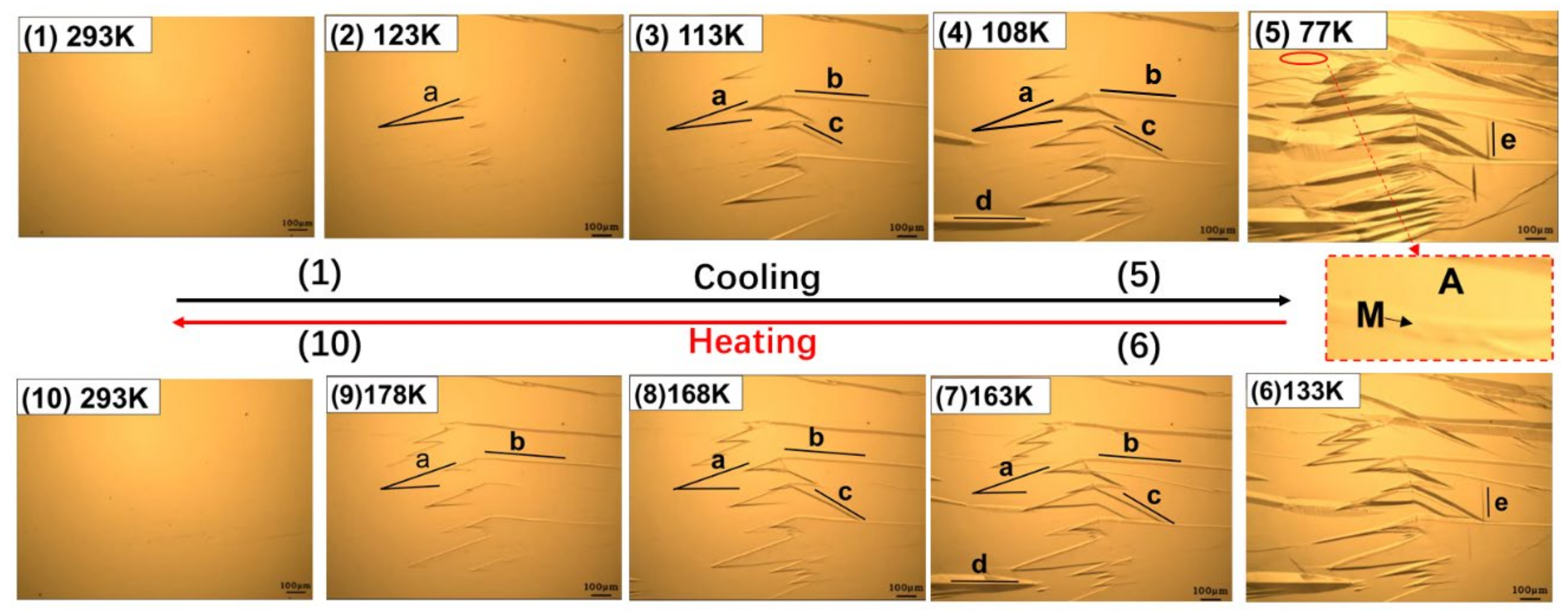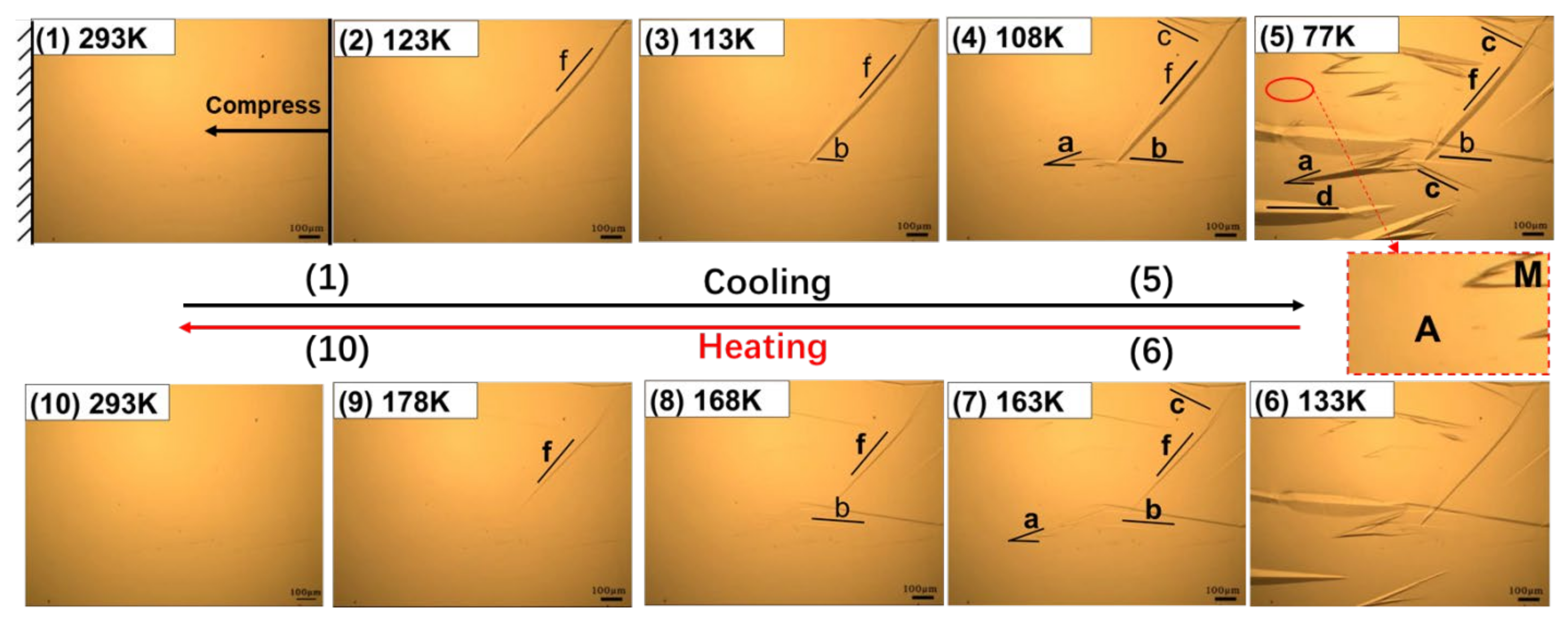In Situ Observation of Thermoelastic Martensitic Transformation of Cu-Al-Mn Cryogenic Shape Memory Alloy with Compressive Stress
Abstract
:1. Introduction
2. Experimental Procedure
3. Experimental Results
3.1. Thermoelastic Martensitic Transformation and Reverse Transformation without Compressive Stress
3.2. Thermoelastic Martensitic Transformation and Reverse Transformation with Compressive Stress
3.3. Synchrotron Radiation X-ray Diffraction
4. Discussion
5. Conclusions
Author Contributions
Funding
Institutional Review Board Statement
Informed Consent Statement
Data Availability Statement
Acknowledgments
Conflicts of Interest
References
- Lecce, L.; Concilio, A. Shape Memory Alloy Engineering; Butterworth-Heinemann Elsevier: Oxford, UK, 2015. [Google Scholar]
- Arun, D.I.; Chakravarthy, P.; Arockia, K.R.; Santhosh, B. Shape Memory Materials; CRC Press: Boca Raton, FL, USA, 2018. [Google Scholar]
- Li, M.; Liu, J.; Yan, S.; Yan, W.; Shi, B. Effect of aging treatment on damping capacity in Cu–Al–Mn shape memory alloy. J. Alloys Compd. 2020, 821, 153213. [Google Scholar] [CrossRef]
- Araki, Y.; Endo, T.; Omori, T.; Sutou, Y.; Koetaka, Y.; Kainuma, R.; Ishida, K. Potential of superelastic Cu-Al-Mn alloy bars for seismic applications. Earthq. Eng. Struct. Dyn. 2011, 40, 107–115. [Google Scholar] [CrossRef]
- Omori, T.; Koeda, N.; Sutou, Y.; Kainuma, R.; Ishida, K. Superplasticity of Cu-Al-Mn-Ni shape memory alloy. Mater. Trans. 2007, 48, 2914–2918. [Google Scholar] [CrossRef] [Green Version]
- Omori, T.; Kawata, S.; Kainuma, R. Orientation Dependence of Superelasticity and Stress Hysteresis in Cu-Al-Mn Alloy. Mater. Trans. 2020, 61, 55–60. [Google Scholar] [CrossRef]
- Greninger, A.B.; Mooradian, V.G. Strain transformation in metastable beta copper-zinc and beta copper-tin alloys. Trans. AIME 1938, 138, 337–368. [Google Scholar]
- Kurdjumov, G.; Khandros, L. On the thermoelastic equilibrium on martensitic transformations. Dokl. Akad. Nauk SSSR 1949, 2, 211–214. [Google Scholar]
- Kainuma, R. Recent Progress in Shape Memory Alloys. Mater. Trans. 2018, 59, 327–331. [Google Scholar] [CrossRef] [Green Version]
- Jani, J.M.; Leary, M.; Subic, A.; Gibson, M.A. A review of shape memory alloy research, applications and opportunities. Mater. Des. 2014, 56, 1078–1113. [Google Scholar] [CrossRef]
- Salzbrenner, R.J.; Cohen, M. On the thermodynamics of thermoelastic martensitic transformations. Acta Metall. 1979, 27, 739–748. [Google Scholar] [CrossRef]
- Tong, H.C.; Wayman, C.M. Thermodynamics of thermoelastic martensitic transformations. Acta Metall. 1975, 23, 209–215. [Google Scholar] [CrossRef]
- Mallik, U.S.; Sampath, V. Effect of composition and ageing on damping characteristics of Cu-Al-Mn shape memory alloys. Mater. Sci. Eng. A Struct. 2008, 478, 48–55. [Google Scholar] [CrossRef]
- Mallik, U.S.; Sampath, V. Influence of aluminum and manganese concentration on the shape memory characteristics of Cu-Al-Mn shape memory alloys. J. Alloys Compd. 2008, 459, 142–147. [Google Scholar] [CrossRef]
- Sutou, Y.; Kainuma, R.; Ishida, K. Effect of alloying elements on the shape memory properties of ductile Cu-Al-Mn alloys. Mater. Sci. Eng. A Struct. 1999, 273, 375–379. [Google Scholar] [CrossRef]
- Zak, G.; Kneissl, A.C.; Zatulskij, G. Shape memory effect in cryogenic Cu-Al-Mn alloys. Scr. Mater. 1996, 34, 363–367. [Google Scholar] [CrossRef]
- Shivaramu, L.; Shivasiddaramaiah, A.G.; Mallik, U.S.; Prashantha, S. Effect of Ageing on Damping Characteristics of Cu-Al-Be-Mn Quaternary Shape Memory Alloys. Mater. Today Proc. 2017, 4, 11314–11317. [Google Scholar] [CrossRef]
- Jiao, Y.Q.; Wen, Y.H.; Li, N.; He, J.Q.; Teng, J. Effect of solution treatment on damping capacity and shape memory effect of a CuAlMn alloy. J. Alloys Compd. 2010, 491, 627–630. [Google Scholar] [CrossRef]
- Mielczarek, A.; Kopp, N.; Riehemann, W. Ageing effects after heat treatment in Cu-Al-Mn shape memory alloys. Mater. Sci. Eng. A Struct. 2009, 521, 182–185. [Google Scholar] [CrossRef]
- Sutou, Y.; Koeda, N.; Omori, T.; Kainuma, R.; Ishida, K. Effects of aging on stress-induced martensitic transformation in ductile Cu-Al-Mn-based shape memory alloys. Acta Mater. 2009, 57, 5759–5770. [Google Scholar] [CrossRef]
- Sutou, Y.; Omori, T.; Wang, J.J.; Kainuma, R.; Ishida, K. Effect of grain size and texture on superelasticity of Cu-Al-Mn-based shape memory alloys. J. Phys. IV 2003, 112, 511–514. [Google Scholar]
- Sutou, Y.; Omori, T.; Okamoto, T.; Kainuma, R.; Ishida, K. Effect of grain refinement on the mechanical and shape memory properties of Cu-Al-Mn base alloys. J. Phys. IV 2001, 11, 185–190. [Google Scholar] [CrossRef]
- Saburi, T.; Wayman, C.M.; Takata, K.; Nenno, S. The shape memory mechanism in 18R martensitic alloys. Acta Metall. 1980, 28, 15–32. [Google Scholar] [CrossRef]
- Otsuka, K.; Shimizu, K. On the crystallographic reversibility of martensitic transformations. Scr. Metall. 1977, 11, 757–760. [Google Scholar] [CrossRef]
- Bhattacharya, K.; Conti, S.; Zanzotto, G.; Zimmer, J. Crystal symmetry and the reversibility of martensitic transformations. Nature 2004, 428, 55–59. [Google Scholar] [CrossRef] [PubMed] [Green Version]
- Lei, Y.; Qin, X.; Wan, F.; Liu, P.; Chen, L.; Wang, J. In-situ observation of martensitic transformation in Cu-Al-Mn cryogenic shape memory alloy. Fusion Eng. Des. 2017, 125, 603–607. [Google Scholar] [CrossRef]
- Otsuka, K.; Wayman, C.M. Shape Memory Materials; Cambridge University Press: Cambridge, UK, 1998. [Google Scholar]
- Zhao, L.C.; Cai, W.; Zheng, Y.F. Shape Memory Effect and Superelasticity in Alloys; National Defense Industry Press: Beijing, China, 2002. [Google Scholar]






| Composition (wt.%) | Ms (K) | ||
|---|---|---|---|
| Cu | Al | Mn | |
| 76.8 | 12.5 | 10.7 | 108 |
Publisher’s Note: MDPI stays neutral with regard to jurisdictional claims in published maps and institutional affiliations. |
© 2022 by the authors. Licensee MDPI, Basel, Switzerland. This article is an open access article distributed under the terms and conditions of the Creative Commons Attribution (CC BY) license (https://creativecommons.org/licenses/by/4.0/).
Share and Cite
Bian, Z.; Song, J.; Liu, P.; Wan, F.; Lei, Y.; Wang, Q.; Yang, S.; Zhan, Q.; Chen, L.; Wang, J. In Situ Observation of Thermoelastic Martensitic Transformation of Cu-Al-Mn Cryogenic Shape Memory Alloy with Compressive Stress. Materials 2022, 15, 3794. https://doi.org/10.3390/ma15113794
Bian Z, Song J, Liu P, Wan F, Lei Y, Wang Q, Yang S, Zhan Q, Chen L, Wang J. In Situ Observation of Thermoelastic Martensitic Transformation of Cu-Al-Mn Cryogenic Shape Memory Alloy with Compressive Stress. Materials. 2022; 15(11):3794. https://doi.org/10.3390/ma15113794
Chicago/Turabian StyleBian, Zhenyu, Jian Song, Pingping Liu, Farong Wan, Yu Lei, Qicong Wang, Shanwu Yang, Qian Zhan, Liubiao Chen, and Junjie Wang. 2022. "In Situ Observation of Thermoelastic Martensitic Transformation of Cu-Al-Mn Cryogenic Shape Memory Alloy with Compressive Stress" Materials 15, no. 11: 3794. https://doi.org/10.3390/ma15113794






